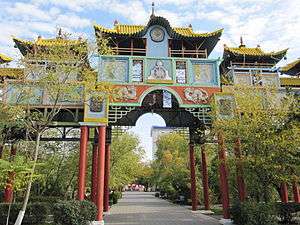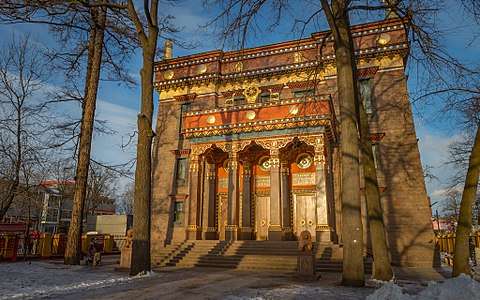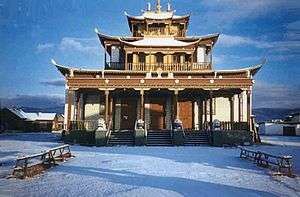Buddhism in Russia
| Part of a series on |
| Vajrayana Buddhism |
|---|
 |
|
Traditions Historical traditions:
New branches:
|
|
History |
|
Pursuit |
|
Practices |
|
Festivals |
|
Ordination and transmission |
|
|
Historically, Buddhism was incorporated into Russian lands in the early 17th century.[1][2] Buddhism is considered as one of Russia's traditional religions, legally a part of Russian historical heritage.[3] Besides the historical monastic traditions of Buryatia, Kalmykia and Tuva, Buddhism is now widespread all over Russia, with many ethnic Russian converts.[4]
The main form of Buddhism in Russia is the Gelukpa school of Tibetan Buddhism, informally known as the "yellow hat" tradition[5], with other Tibetan and non-Tibetan schools as minorities.[6] Although Tibetan Buddhism is most often associated with Tibet, it spread into Mongolia, and via Mongolia into Russia.[1]
Datsan Gunzechoinei in Saint Petersburg, the northernmost Buddhist temple in Russia
History
The first evidence of the existence of Buddhism in the territory of modern Russia belong to the 8th century AD. E. And are associated with the state of Balhae, which in 698-926 occupied part of today's Primorye and Amur. The Mohe, whose culture was greatly influenced by neighboring China, Korea and Manchuria, professed the Buddhism of one of the Mahayana directions. It primarily spread into the Russian constituent regions geographically or culturally adjacent to Mongolia, or inhabited by Mongolian ethnic groups: Buryatia, Zabaykalsky Krai, Tuva, and Kalmykia, the latter being the only Buddhist region in Europe, located to the north of the Caucasus. By 1887, there were already 29 publishing houses[1] and numerous datsans.[1] After the Russian Revolution, the datsans were closed down.[7] By the 1930s, Buddhists were suffering more than any other religious community in the Soviet Union[2] with lamas being expelled and accused of being "Japanese spies" and "the people's enemies".[1]
Revival

After the fall of the Soviet Union, a Buddhist revival began in Kalmykia with the election of President Kirsan Ilyumzhinov.[6] It was also revived in Buryatia and Tuva and began to spread to Russians in other regions.
In 1992, the Dalai Lama made his first visit to Tuva in Russia.[8]
There are several Tibetan Buddhist university-monasteries throughout Russia,[9] concentrated in Siberia, known as Datsans.[7]
Fyodor Shcherbatskoy, a renowned Russian Indologist who traveled to India and Mongolia during the time of the Russian Empire, is widely considered by many to be responsible for laying the foundations for the study of Buddhism in the Western world.
There are now between 700,000 and 1.5 million Buddhists in Russia, mainly in the republics of Buryatia, Kalmykia and Tuva.[10]
Regions with large Buddhist populations
| Federal subject | Buddhism (2016)[11] |
|---|---|
| 62.2% | |
| 53.4% | |
| 19.8% | |
| 14.6% | |
| 0.8% |

.png)
In 2012 it was the religion of 62% of the total population of Tuva, 38% of Kalmykia and 20% of Buryatia.[12] Buddhism also has believers accounting for 6% in Zabaykalsky Krai, primarily consisting in ethnic Buryats, and of 0.5% to 0.9% in Tomsk Oblast and Yakutia. Buddhist communities may be found in other federal subjects of Russia, between 0.1% and 0.5% in Sakhalin Oblast, Khabarovsk Krai, Amur Oblast, Irkutsk Oblast, Altay, Khakassia, Novosibirsk Oblast, Tomsk Oblast, Tyumen Oblast, Orenburg Oblast, Arkhangelsk Oblast, Murmansk Oblast, Moscow and Moscow Oblast, Saint Petersburg and Leningrad Oblast, and in Kaliningrad Oblast.[12] In cities like Moscow, Saint Petersburg and Samara, often up to 1% of the population identify as Buddhists.[13]
See also
- India–Russia relations
- Buddhism in Buryatia
- Buddhism in Kalmykia
- Datsan - Buddhist temples in Russia
- Datsan Gunzechoinei
References
- 1 2 3 4 5 Buddhism in Russia at Buddhist.ru
- 1 2 Buddhism in Russia
- ↑ Bell, I (2002). Eastern Europe, Russia and Central Asia. ISBN 978-1-85743-137-7. Retrieved 27 Dec 2007.
- ↑ Research Article- Ostrovskaya - JGB Volume 5 Archived 2007-07-17 at the Wayback Machine.
- ↑ Holland, Edward C. (Dec 2014). "Buddhism in Russia: challenges and choices in the post-Soviet period". Religion, State and Society. 42 (4): 389–402. doi:10.1080/09637494.2014.980603.
- 1 2 Буддизм в России
- 1 2 "Buddhism in Russia". www.advantour.com. Retrieved 12 September 2017.
- ↑ "RUSSIA: When will Dalai Lama next visit Tuva? - WWRN - World-wide Religious News". wwrn.org. Retrieved 12 September 2017.
- ↑ Tricycle. "lettucecomic". Retrieved 12 September 2017.
- ↑ "Putin Promises 100% Support for Buddhists". Ria Novosti. Archived from the original on 14 April 2013. Retrieved 15 April 2017.
- ↑ "ФСО доложила о межконфессиональных отношениях в РФ". ZNAK. Retrieved 15 April 2017.
- 1 2 "Арена: Атлас религий и национальностей" [Arena: Atlas of Religions and Nationalities] (PDF). Среда (Sreda). 2012. See also the results' main interactive mapping and the static mappings: "Religions in Russia by federal subject" (Map). Ogonek. 34 (5243). 27 August 2012. Archived from the original on 21 April 2017. The Sreda Arena Atlas was realised in cooperation with the All-Russia Population Census 2010 (Всероссийской переписи населения 2010) and the Russian Ministry of Justice (Минюста РФ).
- ↑ Filatov & Lunkin 2006, p. 38.
Bibliography
- Juergensmeyer, Mark (2006). The Oxford Handbook of Global Religions. Oxford University Press, USA. pp. 309–310. ISBN 978-0-19-972761-2.
External links
- The Buddhist hordes of Kalmykia, The Guardian September 19, 2006
- Buddhactivity Dharma Centres database
- Gusinoye Ozero, seat of imperial Russia's Buddhists
- Buddhist Paintings in Buryatia
- History of Tibetan Buddhism in Inner Asia in the 20th Century
- Buryats culture and traditions
- Pandito Khambo Lama Itigelov's Most Precious Body 10/9/05)
